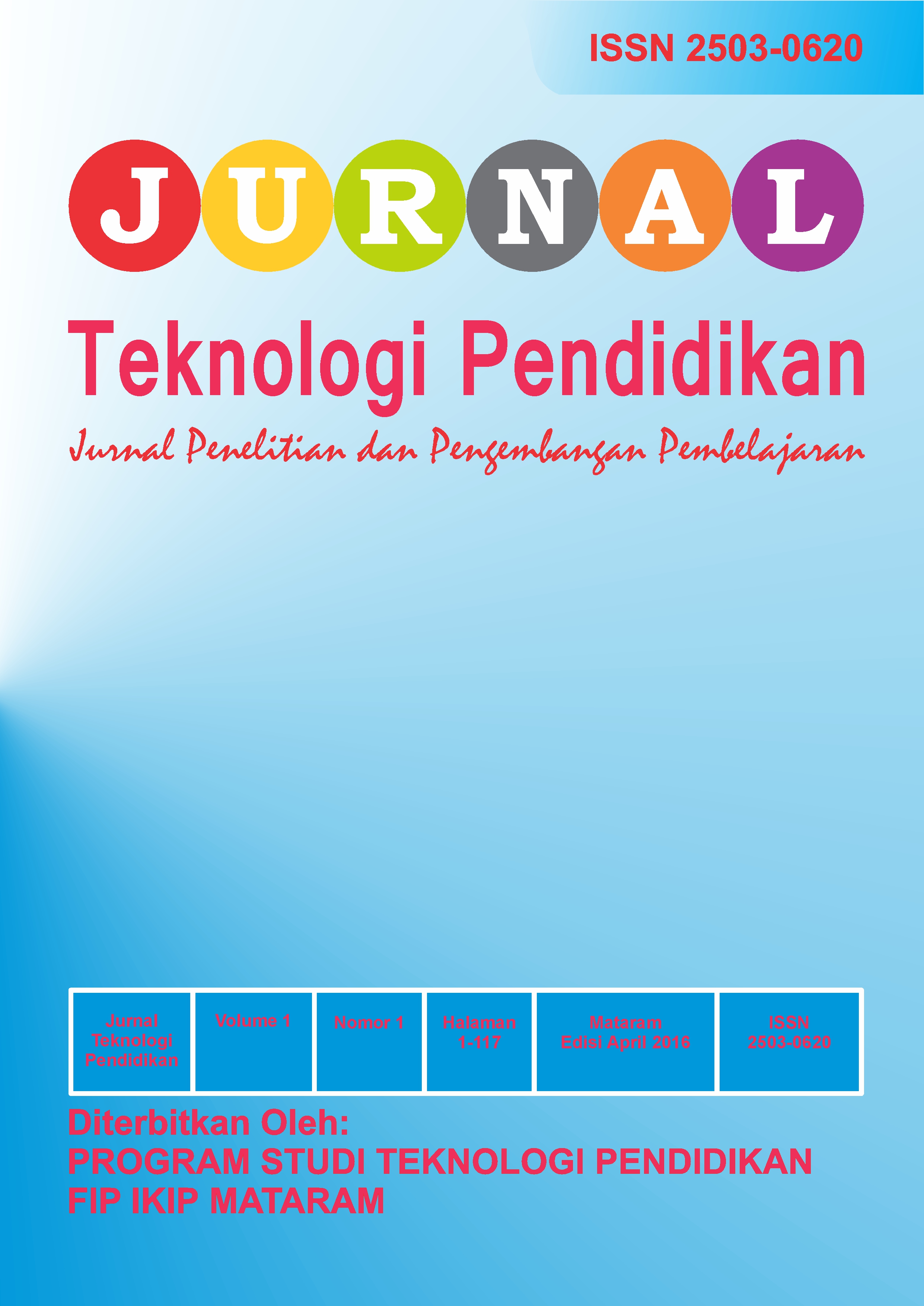PEMBELAJARAN MODEL KOOPERATIF TIPE TSTS BERORIENTASI KULTUR KEPESANTRENAN UNTUK MENINGKATKAN KEMAMPUAN KOMUNIKASI MATEMATIKA KELAS VII
DOI:
https://doi.org/10.33394/jtp.v1i1.601Abstract
Penelitian ini bertujuan untuk menghasilkan perangkat pembelajaran aritmetika sosial dengan model pembelajaran kooperatife tipe TSTS berorientasi kultur kepesantrenan yang valid, praktis, dan efektif. Jenis penelitian ini adalah pengembangan dengan menggunakan model Plomp yang dimodifikasi menjadi empat tahap, yaitu: (1) investigasi awal, (2) desain, (3) realisasi dan konstruksi, dan (4) tes, evaluasi, dan revisi. Perangkat pembelajaran yang dikembangkan meliputi: silabus, Rencana Pelaksanaan Pembelajaran (RPP), Lembar Kerja Siswa (LKS), Bahan ajar (BA), dan Tes Kemampuan Komunikasi Matematika (TKKM). Subjek pada penelitian ini adalah seluruh siswa kelas VII SMP Islam Roudlotus Saidiyyah Semarang semester genap Tahun Pelajaran 2013/2014. Implementasi perangkat ini menghasilkan (1) nilai rata-rata kemampuan komunikasi matematika kelas eksperimen 75,74 dari KKM 65, (2) nilai rata-rata angket i`timadu ala-annafsi (kemndirian) 65,5, rata-rata hasil pengamatan maharatu alkalamu (keterampilan komunikasi) 39,35, pengaruh i`timadu ala-annafsi dan maharatu alkalamu terhadap kemampuan komunikasi matematika sebesar 82,2%, dan (3) rata-rata peningkatan kemampuan komunikasi kelas eksperimen dan kelas kontrol adalah 0,56 dan 0,25. Uji beda rata-rata peningkatan menunjukkan rata-rata peningkatan kemampuan komunikasi matematika siswa kelas eksperimen lebih baik dari siswa kelas kontrol.
Kata Kunci : Kooperatif TSTS, Pesantren, Matematika.
References
Ahmad, Z. & N., Mahmood, 2010. “Pengaruh Pembelajaran KooperatifVS Tradisionalâ€. International Journal of Faculty of Educational Sciences, Volume 43 No. 1. Hal 160.
Amiripour, P., M. Najafi, & A. Shahvarani. 2012. “Application of Cooperative Learning Method in Geometry Instructionâ€. International Journal of Emerging Trends in Engineering and Development, Volume 2 No. 2. Hal. 162.
Benson, G. C. S. & T. S., Engeman,. 1974. “Practical Possibilities in American Moral Education.†Journal of Moral Education, Volume 4 No. 1 . Hal 53-59.
Cohen, E. G. 1994. “Restructuring the Classroom: Conditions for Productive
Small Groups.†Review of Educational Research, Volume 64 No. 1. Hal 25.
Eisenhauer, G. & B. Creek. 2007. “Cooperative Learning as an Effective Way to Interact.†Action Research Project Report in Partial Fulfillment of the MAT Degree Department of Mathematics University of Nebraska-Lincoln.
Gyasi, W. K. 2013. “Impact of Effective Communication on Mathematics Education in Ghanaian Senior High Schools – Teacher’s Role.†Asian Journal of Humanities and Social Studiesâ€, Volume 1 No. 1. Hal 25-26.
Hake, R. 1998. “Interactive-Engagement Versus Traditional Methods: A Six-Thousand-Student Survey of Mechanics Test Data for Introductory Physics Courses.†American Association of Physics Teachers, Volume. 6 No. 1. Hal. 64-74.
Hapsari, S. A dan Sutama. 2103.Kontribusi Kemandirian Terhadap Hasil Belajar Matematika Ditinjau dari Fasilitas Belajar dan Jarak Tempat Tinggal Siswa Smk. Disampaikan Pada Seminar Nasional Pendidikan Matematika Surakarta, 15 Mei 2013.
Kennedy, N. S. 2009. “Toward a Dialogical Pedagogy: Some Characteristics of Community of Mathematics Inquiryâ€. Eurasia Journal of Mathematics, Science and Technology Educations, Volume 5 No. 1. Hal 380.
Ma’arif, S. 2012. “Transformative Learning Dalam Membangun Pesantren Berbasis Multikultural.†Jurnal Pembangunan Pendidikan: Fondasi dan Aplikasi, Volume 1 No. 1. Hal. 68.
Pratiwi, D. D., I. Sujadi, & Pangadi. 2012. Kemampuan Komunikasi Matematis Matematika Sesuai Dengan Gaya Kognitif Pada Siswa Kelas IX SMP Negeri 1 Surakarta.
Riduwan. 2010. Dasar-Dasar Statistika. Bandung : Alfabeta.
Saraswati, D, E. Soedjoko ,& B.E. Susilo. 2012. “Penerapan Pembelajaran Two Stay-Two Stray terhadap Kemampuan Pemahaman Konsep dan Minat.†Unnes Journal of Mathematics Education, Volume. 1 No. 1. Hal. 36.
Shield, M. & K., Swinson. 1996. â€The Link Shet: A Comunication Aid for Clarifying and Developing Mathematical Ideas and Processesâ€. In. P. C. Elliot and M. J Kenney (Eds). Year Book 1996. Comunication in Mathematics K-12 and Beyond. USA: NCTM.
Suherman, E, et al. 2003. Strategi Pembelajaran Matematika Kontemporer. Universitas Pendidikan Indonesia.
Suyitno, H. 2012. Nilai-nilai Pendidikan Karakter Bagi Pembentukan Karakter Bangsa. Makalah Seminar Nasional di Universitas Negeri Semarang 13 Oktober 2012.
Tandilling, E. 20012. “Mengembangan Instrumen Untuk Mengukur Kemampuan Komunikasi Matematik, Pemahaman Matematik, Danself- Regulated Learningsiswa Dalam Pembelajaran Matematika Di Sekolah Menengah Atasâ€. Jurnal Penelitian Pendidikan, Volume 13 No. 1. Hal. 25.
Widjajanti, D.B, & Wahyudin. 2010. Mengembangkan Kemampuan Komunikasi Matematis Mahasiswa Calon Guru Matematika Melalui Strategi Perkuliahan Kolaboratif Berbasis Masalah. Makalah KNM 2010.
Zakaria, E, et al. 2013. “Effect of Cooperative Learning on Secondary School Students’ Mathematics Achievementâ€. Creative Education, Volume 4 No. 2. Hal. 98-99.
Downloads
Published
How to Cite
Issue
Section
License
License and Publishing Agreement
In submitting the manuscript to the journal, the authors certify that:
- They are authorized by their co-authors to enter into these arrangements.
- The work described has not been formally published before, except in the form of an abstract or as part of a published lecture, review, thesis, or overlay journal.
- That it is not under consideration for publication elsewhere,
- That its publication has been approved by all the author(s) and by the responsible authorities – tacitly or explicitly – of the institutes where the work has been carried out.
- They secure the right to reproduce any material that has already been published or copyrighted elsewhere.
- They agree to the following license and publishing agreement.
Copyright
- Authors who publish with JTP agree to the following terms:
- Authors retain copyright and grant the journal right of first publication with the work simultaneously licensed under a Creative Commons Attribution License (CC BY-SA 4.0) that allows others to share the work with an acknowledgment of the work's authorship and initial publication in this journal.
- Authors are able to enter into separate, additional contractual arrangements for the non-exclusive distribution of the journal's published version of the work (e.g., post it to an institutional repository or publish it in a book), with an acknowledgment of its initial publication in this journal.
- Authors are permitted and encouraged to post their work online (e.g., in institutional repositories or on their website) prior to and during the submission process, as it can lead to productive exchanges, as well as earlier and greater citation of published work.
- Licensing for Data Publication
Licensing for Data Publication
JTP use a variety of waivers and licenses, that are specifically designed for and appropriate for the treatment of data:
Open Data Commons Attribution License, http://www.opendatacommons.org/licenses/by/1.0/ (default)



.png)

